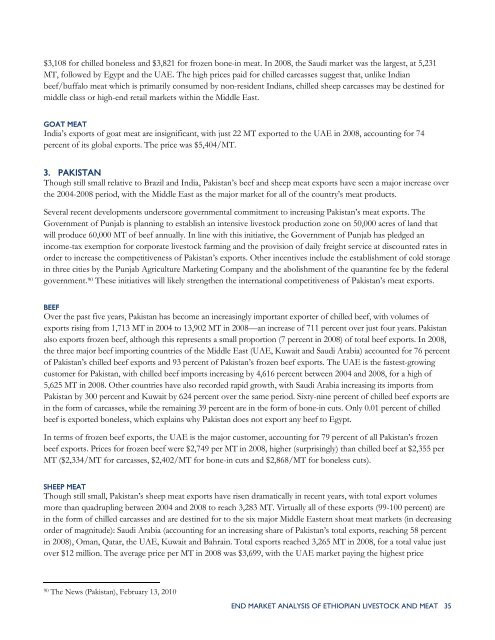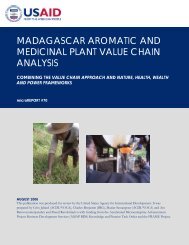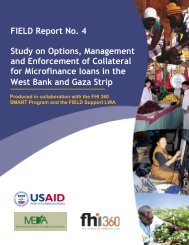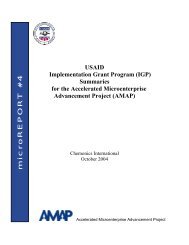End Market Analysis of Ethiopian Livestock and ... - USAID Microlinks
End Market Analysis of Ethiopian Livestock and ... - USAID Microlinks
End Market Analysis of Ethiopian Livestock and ... - USAID Microlinks
You also want an ePaper? Increase the reach of your titles
YUMPU automatically turns print PDFs into web optimized ePapers that Google loves.
$3,108 for chilled boneless <strong>and</strong> $3,821 for frozen bone-in meat. In 2008, the Saudi market was the largest, at 5,231<br />
MT, followed by Egypt <strong>and</strong> the UAE. The high prices paid for chilled carcasses suggest that, unlike Indian<br />
beef/buffalo meat which is primarily consumed by non-resident Indians, chilled sheep carcasses may be destined for<br />
middle class or high-end retail markets within the Middle East.<br />
GOAT MEAT<br />
India’s exports <strong>of</strong> goat meat are insignificant, with just 22 MT exported to the UAE in 2008, accounting for 74<br />
percent <strong>of</strong> its global exports. The price was $5,404/MT.<br />
3. PAKISTAN<br />
Though still small relative to Brazil <strong>and</strong> India, Pakistan’s beef <strong>and</strong> sheep meat exports have seen a major increase over<br />
the 2004-2008 period, with the Middle East as the major market for all <strong>of</strong> the country’s meat products.<br />
Several recent developments underscore governmental commitment to increasing Pakistan’s meat exports. The<br />
Government <strong>of</strong> Punjab is planning to establish an intensive livestock production zone on 50,000 acres <strong>of</strong> l<strong>and</strong> that<br />
will produce 60,000 MT <strong>of</strong> beef annually. In line with this initiative, the Government <strong>of</strong> Punjab has pledged an<br />
income-tax exemption for corporate livestock farming <strong>and</strong> the provision <strong>of</strong> daily freight service at discounted rates in<br />
order to increase the competitiveness <strong>of</strong> Pakistan’s exports. Other incentives include the establishment <strong>of</strong> cold storage<br />
in three cities by the Punjab Agriculture <strong>Market</strong>ing Company <strong>and</strong> the abolishment <strong>of</strong> the quarantine fee by the federal<br />
These initiatives will likely strengthen the international competitiveness <strong>of</strong> Pakistan’s meat exports.<br />
government. 90<br />
BEEF<br />
Over the past five years, Pakistan has become an increasingly important exporter <strong>of</strong> chilled beef, with volumes <strong>of</strong><br />
exports rising from 1,713 MT in 2004 to 13,902 MT in 2008—an increase <strong>of</strong> 711 percent over just four years. Pakistan<br />
also exports frozen beef, although this represents a small proportion (7 percent in 2008) <strong>of</strong> total beef exports. In 2008,<br />
the three major beef importing countries <strong>of</strong> the Middle East (UAE, Kuwait <strong>and</strong> Saudi Arabia) accounted for 76 percent<br />
<strong>of</strong> Pakistan’s chilled beef exports <strong>and</strong> 93 percent <strong>of</strong> Pakistan’s frozen beef exports. The UAE is the fastest-growing<br />
customer for Pakistan, with chilled beef imports increasing by 4,616 percent between 2004 <strong>and</strong> 2008, for a high <strong>of</strong><br />
5,625 MT in 2008. Other countries have also recorded rapid growth, with Saudi Arabia increasing its imports from<br />
Pakistan by 300 percent <strong>and</strong> Kuwait by 624 percent over the same period. Sixty-nine percent <strong>of</strong> chilled beef exports are<br />
in the form <strong>of</strong> carcasses, while the remaining 39 percent are in the form <strong>of</strong> bone-in cuts. Only 0.01 percent <strong>of</strong> chilled<br />
beef is exported boneless, which explains why Pakistan does not export any beef to Egypt.<br />
In terms <strong>of</strong> frozen beef exports, the UAE is the major customer, accounting for 79 percent <strong>of</strong> all Pakistan’s frozen<br />
beef exports. Prices for frozen beef were $2,749 per MT in 2008, higher (surprisingly) than chilled beef at $2,355 per<br />
MT ($2,334/MT for carcasses, $2,402/MT for bone-in cuts <strong>and</strong> $2,868/MT for boneless cuts).<br />
SHEEP MEAT<br />
Though still small, Pakistan’s sheep meat exports have risen dramatically in recent years, with total export volumes<br />
more than quadrupling between 2004 <strong>and</strong> 2008 to reach 3,283 MT. Virtually all <strong>of</strong> these exports (99-100 percent) are<br />
in the form <strong>of</strong> chilled carcasses <strong>and</strong> are destined for to the six major Middle Eastern shoat meat markets (in decreasing<br />
order <strong>of</strong> magnitude): Saudi Arabia (accounting for an increasing share <strong>of</strong> Pakistan’s total exports, reaching 58 percent<br />
in 2008), Oman, Qatar, the UAE, Kuwait <strong>and</strong> Bahrain. Total exports reached 3,265 MT in 2008, for a total value just<br />
over $12 million. The average price per MT in 2008 was $3,699, with the UAE market paying the highest price<br />
90 The News (Pakistan), February 13, 2010<br />
END MARKET ANALYSIS OF ETHIOPIAN LIVESTOCK AND MEAT 35





